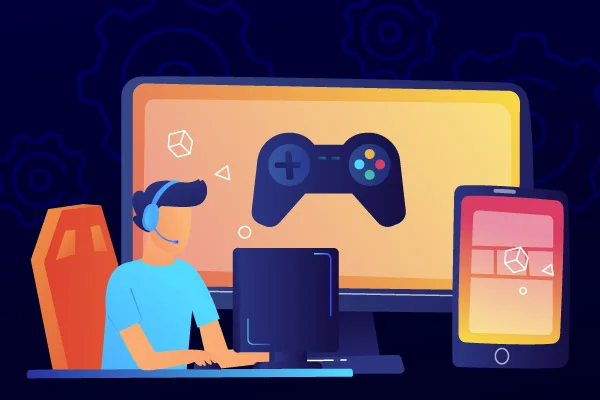
Modern Game Design Process: Pre to Post Production
When thinking about the game design process, every great game should start with one thing — a clear vision. A vision that can be carried through the project is more important than any other aspects of the game design process.
What is the Game Design Process?
The game design process starts with outlining this vision in a game design document (GDD). The purpose of this document is to organize ideas and teams to help keep everyone aligned as they develop.
But this is where a lot of teams can struggle. Projects that are managed with documents only do so much to express a vision. They don’t evolve fast enough. In today’s world, Agile teams need their processes to match their quick pace. And game design docs can quickly become outdated as you prototype and play.
You need a way to transport and evolve your vision throughout the game development process. So how can you transform your vision into a must-play game?
Back to top5 Elements of Game Design Process
We'll walk you through a game design process that basically consists of 5 steps:
- Prototype
- Pre-production
- Defining your toolset
- Production
- Post-production
Back to topNeed a Planning Tool with an On-Prem Hosting Option?
Helix Plan Agile planning software offers both cloud and on-prem hosting. And it's free for small teams.
Game Design Process: Early Stages
The first step to a game design process is to prototype a concept. Make early decisions around the core ideas. How should the artwork look? What feeling the game should have? Every single detail of the game does not have to be outlined. But there should be a solid idea of what will make the game fun.
One example can be to try to prototype a physical board game version. Then sit around a table with a few friends and try it out. The experience will be far from what your game will end up being. Although, it can still give you very important clues about what needs to happen next.
Shotgun Approach to Your Game Design Process
Then you need to start figuring out what you want to build and how. Who is going to play it? How will your users to engage with content, pay for it, interact with other users, etc.? Can you use a game engine to build it (otherwise it will be a lot of extra work)? And the most important question remains — will it still be fun? Because without the fun, a game isn’t worth playing!
At this point, you should have enough information to get a rough estimate of how much funding and time the game will require. If you want to convince a publisher to fund you, they will definitely require some documentation.
Describing your ideas for fun in a document is not very exciting. Very few want to read a rule book to learn how to play a game! A faster way can be to use a product backlog where you structure the different elements of the game and can attach detailed information, like high-level estimates.
You might quickly build out some of your ideas and evaluate them over a short period of time. Peer review and play can help you find out what is the most fun. You can figure out the answers to these questions and your team gets to interact with your concept. Then you can narrow down your vision. You could create an early ‘vertical slice’ that highlights every aspect of the game.
Coming up with a single vision is the creative and fun part of the game design process. But then you need something — or someone — to figure out how to actually build it. This vision carrier should push your idea to its final release.
Back to topWhat’s the Future of Game Development?
New game development trends emerge every year. Learn what’s on the horizon.
Game Design Process: Pre-Production
During the pre-production phase, you dive deeper into figuring out what you are going to do and what you are going to need to do it. You should already be clear on who will be playing your game. Then you need to define your team setup, toolset, and business model to match. These critical components are the foundation of your game design process.
How to Structure Your Teams
Different games require you to structure your team differently. In the times of COVID, with everyone working remotely, it is even more important to figure out how you will work. You want to set up your teams to enhance communication.
Some teams may try a cross-functional approach. This can create small, nimble groups that have a couple of different skillsets working together on a specific feature. Other teams may separate teams by discipline and bring them together later to build aspects of your game.
However you structure your teams, ensure it matches your overall game design process. You need everyone on your team to come together under your vision. Consider Conway’s Law – your communication structure will strongly influence how your game will look.
How Top Studios Structure Teams to Build Award Winning Games >>
Building the Game — Do You Need a Game Designer?
The industry is a bit divided when it comes to how to carry a vision throughout a game. For example, in some cultures, a creative director owns all decisions when it comes to game design. Some choose to hire game designers to have this function while others let the producers own much of carrying the vision throughout the project.
A professional game designer is someone with experience who can actually build the idea for the game for your team. They can help you identify the right mechanics, balance, and also function as a vision carrier throughout the project.
But some teams simply want the people that build the game to be in charge of the game design process. Whether or not you have a game designer, it is important to have someone that is charge of the vision. They should create goals for major milestones to ensure the end product does not land too far away from the original idea (unless you discover good reasons to pivot).
As development evolves, your game designer or vision carrier needs to identify pitfalls in your game design process, generate possible solutions, and effectively communicate them to the team.
This person is accountable for both finding the fun and working with the teams to itemize actionable pieces of work. Game design is not an easy task, so ensure that this is not just added on to the plate of one of your designers or developers. Because then, tasks may not get done. Someone needs to be in charge of your process to force teams to step back, refocus, and push through with the best solution possible.
Delivering the Game – Do You Need a Producer?
One issue with a very strong vision carrier is that it may create too much scope, risking the overall project deadline. Many studios suffer from perfectionism and have a hard time sticking with the original timeline. This is why the role of having a producer can be so important.
A producer is someone that understands both the game development process and has excellent people and project management skills. Because during any game design process, you will have to make sacrifices. Producers can help you be smart about those choices. And they can encourage team members to deliver work continuously.
Back to topHow to Define Your Toolset
Tools define not only how you will build a game, but how teams will work together. There are a few critical tools you will need.
Product Backlog & Planning Tool
Project management tools structure your sprints and organize your backlog. Having one backlog to rule over the game is essentially a living, breathing game design document. It should be able to adapt as you hit roadblocks and come up with new ideas. Backlogs can adapt more easily than a game design document. But they need to be visible and managed so they do not become unruly. You will also use this tool to balance your capacity and scope.
How to Master Your Mega Backlog >>
Version Control
Version control is an essential part of any development team. The right version control system should have plugins available for both your developers and designers. It also should be able to store all your digital assets, so you have a single source of truth for your final game. This will elevate your build quality and enhance visibility into how your game evolves.
Game Engine
When it comes to game engines, there is a lot to choose from. What you choose depends a lot on your team and project. But one of the most popular choices is Unreal Engine by Epic.
Back to topGame Design Process: Production
Production is a major milestone in your game design process. Your vision carrier should work to ensure this is accomplished by a certain date. Setting up different goals at key stages can help you stay on task.
It is important to remember to continuously validate the fun! Set aside time for your developers and designers to actually play the game. Gather feedback from family and friends. The point is to not keep it a secret on your computer. Put on a headset and ensure your game design process produces the best outcome. If you are still just using a game design document to evaluate your process, then you will no idea if a game is fun until you start selling it.
Back to topModern game design process requires you evaluate by actually playing your game!
Game Design Process: Post-Production
Depending on your business model, post-production can vary. Some games are continuously releasing new features, levels, and accessories. Others prepare for one big final release. No matter your method, your game design process should match your business model.
Back to topWhat Your Game Design Process Needs
If you have been working in game development, you have probably heard the words, “Don’t read those. They’re outdated.” If this is your game design process document, you are relying on team members to just know what to build. We all know that games rarely match their initial concepts, so you need to keep everything up to date as it evolves.
But you do not have to rely on word of mouth. There’s a better way. Using the right project management tools — and unifying your backlog — can keep everyone on the same page. This is because your backlog defines how your work is organized. It can be a can continuously evolve.
Backlog Management for Modern Game Design Process
With Helix Plan (formerly Hansoft)— the product management tool built by games devs for game devs — you can do just that. Helix Plan backlog functionality scales so you can easily manage even the largest products.
With advanced dashboard functionality, everyone on your team can quickly see how your individual items mirror your overall vision. Now your game design process can be Agile, just like your team. When you hit a milestone, you can also easily customize and export reports to give a high-level view of your game.
Don’t be so uptight about the game design process – the goal is to find the fun and vision and carry it through. Things will change. Adapt. Be Agile. Keep everyone up to date as things change with Helix Plan.
Learn more about your game development process.
Back to top